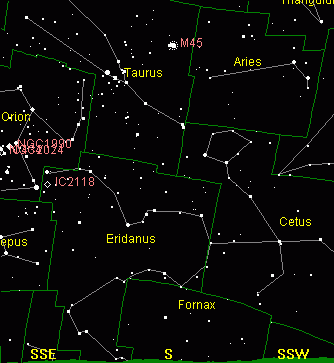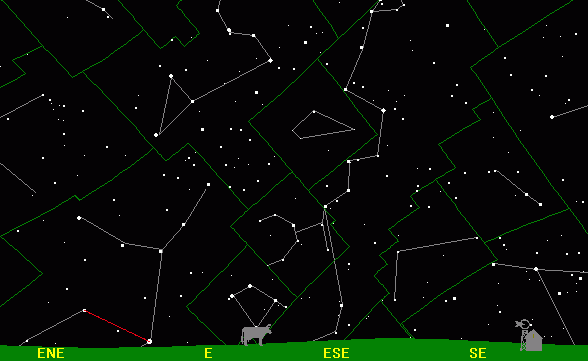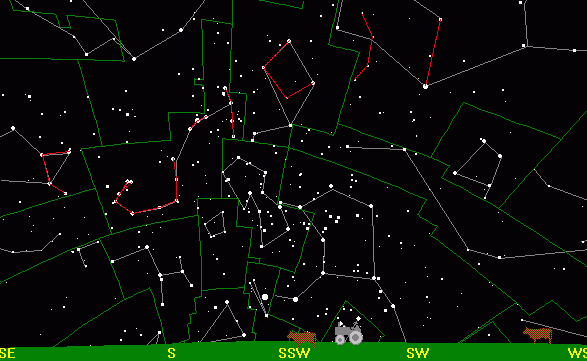All statements in Yijing are short, concise, and contain no redundancy. If we want to understand statements in Yijing, we need to understand the image of the hexagram.Take for example hexagram 1, Qian. Ancient sages chose the Eastern Blue Dragon constellation to represent Yang, because the position of the Dragon at early evening indicated the farming season for farmers in the ancient age. The move of Eastern Blue Dragon constellation represents the movement of heaven and the growth of Yang. According to yin-yang theory Yang starts to grow at Zi and extends to its limit at Wu.
Ancient Chinese determined the passage of time and seasons through the astronomical phenonmena in southern sky at early evening. Referring to the chapter THE CANON OF YAO of SHU JING (SHU CHING), in mid-winter the star Mao was up at the southern sky at early evening, and the Dragon was invisible. The Eastern Dragon was under the surface of the ground, below the horizon. The first/initial line statement say, "Hidden dragon. Do not act."

About 45 days later, the Eastern Dragon's horn appears on the eastern horizon at early evening, and the season is early spring. The second line statement says, "Appearance of Dragon in the field; it will be advantageous to see the great man."

Until the mid-summer, the entire Dragon has risen to the highest location in southern sky at early evening. After that, the dragon moves western and sinks, and finally the Dragon will disappear in west. The top line statement say, "The dragon of the highest has regret." The regret of Dragon is "As soon as a thing reaches its extremity, it reverses its course." It means that the dragon regrets about his sinking after he reached the highest.

Hexagram statements are based on the image of the hexagram. And, line statements are based on the relationship of the line to lines.
How to explain the statement of the top line of Qian that arose from your consultation? Does the statement indicate that you surely has regret?
Xici Zhuan (Great Appendix) says that "Auspicious" and "Inauspicious" expresses its loss and gain; "Regret" and "Distress" expresses like little flaws; "There is no trouble" expresses patching mistakes.
It is clear that each of statements does not simply tell you the omen of auspiciousness nor inauspiciousness but the key.
Xici Zhuan (Great Appendix) says,
The dragon of the highest has regret. Confucius said: "He is noble but without position, high but without the people. The sage man is beneath him and does not assist him. Therefore, he moves then has regret.""He is noble but without position, high but without the people" indicates that the nine at top (yang yao, unbroken line) is at the incorrect yin position, "without the people" is caused by the incorrect position. "The sage man is beneath him and does not assist him" indicates that there is yang yao at the third yang position, and there is unfriendly interaction between the top position and the third. "He moves then has regret" indicates that the "move" is the key to "having regret".
Wenyan Zhuan says, "The dragon of the highest has regret, it is the calamity of extremity....... knowing to advance but not knowing to retire; knowing existence but not knowing perish; knowing gain but not knowing loss."
It means that "extremity" and "moving forward" are the key points, and these key points decide whether the outcome is auspicious or not.
Example:
Duke Zhau (Tso Chuan), 12th Year -- 529 B.C. (Legge, p. 637, col. 7 & p. 640, col. 1)When Nan Kuai was about to revolt, ........, Nan Kuai consulted by some twigs about his object, without mentioning it and got the diagram Kun which then became Bi (1). As it is said [upon the changed line], "Yellow for the lower garment; great good fortune (2)," he thought this was very lucky and showed it to Zi Fu Hui Bo, saying, "If I am contemplating something, how does this indicate it will turn out?"
Hui Bo replied, "I have learned this: If the thing be one of loyalty and good faith, you may go forward with it. If it be not, it will be defeated.(3) The outer figure indicates strength, and the inner mildness: expressive of loyalty. We have [also] harmony leading on solidity: expressive of fidelity. hence the words, ' Yellow for the lower garment; greatness and good fortune.' But yellow is the color of the center (4); the lower garment (5) is the ornament of that which is beneath; that greatness is the height of goodness. If in the center [= the heart] there is not loyalty, there cannot be the color (6); if below [= in an inferior] there be not the respectful discharge of duty, there cannot be the ornament (7); if the affair be not good, there cannot be that height (8). When the outer and inner are mutually harmonious, there is loyalty; when affairs are done in fidelity, there is that discharge of duty; an earnest nourishing of the three virtues makes that goodness. Where there are not these three things, this diagram does not apply. Moreover, [this passage of] the Yi cannot be a guide about anything hazardous. What thing are you contemplating that should require that ornamenting? With what is admirable in the center, you can predicate the yellow; with what is admirable above, you can predicate that great goodness; with what is admirable below, you can predicate that lower garment. Given these three all complete, and you may consult the reeds. If they are defective, though the consultation may [seem to] be lucky, it is not to be acted on." .............. (9)
(1) The fifth six of Kun has changed,


(2) Line statement of the fifth six of Kun.
(3) Conformity, straightness, firmness and largeness are virtues of Kun.
(4) Yellow is the regular color of earth.
(5) Kun is the emblem of lower garment, Qian is the emblem of upper garment. Garment is ornament to human.
(6) The sentences mean that if there is not loyalty in the heart, there cannot be the yellow color.
(7) not the lower garment. the image statement reads ornaments are in the heart.
(8) without the virtue of center
(9) Nan Kuai was ultimately defeated.
A hexagram consists of two trigrams, and includes two nuclear trigrams. Every trigram represents many things. Knowing images of each trigram helps a lot to interpret a hexagram. If the statement does not relate to your question, knowing images of each trigram is particularly important to interpret the hexagram. Some Yi scholars like to play the game of guessing the object concealed in the bowl. The following examples are taken from a book of a scholar.
Example 1:
In new year, I played the game guessing the object concealed in the bowl with children at leissure. My grandson concealed a stick of match in the bowl. I consulted by divination about the object and got the hexagram Fengwhich then became Zhen
. It showed having flammable matrial (innner trigram Li) which connected to wood (the nuclear trigram Xun). Striking it caused explosion (Zhen denoted move and explosion). The blaze was brilliant as lightning (Li denoted brightness, Zhen denoted thunder). I said it was match. The image showed that fire connected with wood, and the Xun denoted straightness, long and white in color. It surely was match.
Example 2:
Child concealed an orange peel and asked for my guessing. I got the hexagram Tongrenwhich then became Wuwang
. I thought the body of this object was round and big-bellied (Heaven denoted round and Li denoted big-bellied), and Qian denoted upper-garment and peel, Zhen denoted shell and sound. Was the object hollow, and was sound produced when the object swung (Zhen denoted sound)? So, i guess it was a small drum. I lifted up the cover and saw that the object was orange peel. Round body, big-bellied, peel, hollow; I had guessed these correctly, only the "sound" was incorrect. Then I thought Qian denoted fruit of trees and upper-garment and Zhen denoted bamboo and reed which were similar to "shell". The nuclear trigram Gen denoted seed-bearing part of plants and Zhen also denoted yellow in color. All of these were the images of orange peel. It was clear that if we could not quieten down and meditate then we could not be deep in guess.
How can we memorize all images of each trigram for explaining and interpreting a hexagram? The best way to memorize all images of each trigram is to understand the primary image of each trigram, because all images derive from the primary image. For example,
Qian is the symbolic of the heavens, and the heavens ceaselessly rotates. So, Qian denotes strength, strong and to keep on going without cease. The heavens seems to the observers as an immense sphere surrounding Earth, an enormous hollow sphere with us in the middle, therefore Qian also denotes circle, spherical thing, etc. We determine seasons through the change of patterns of the heavens, constellations, these patterns seem like the instructions of the heavens to us about the best and favorable days to plant, to harvest, etc. Accordingly Qian denotes monarch, father, etc.
.......
.......
.......I hope the above information is helpful to you to understand Yi Jing.

Back to Yi Divination Methods